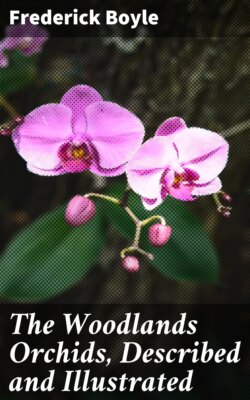Читать книгу The Woodlands Orchids, Described and Illustrated - Frederick Boyle - Страница 8
На сайте Литреса книга снята с продажи.
Cattleya Mendelii
ОглавлениеTable of Contents
The next division is styled the Mendelii house; more than three hundred large examples of this species—to be accurate and pedantic, it should be called a variety—occupy the centre, a hundred and eighty the stand to right.
Cattleya Mendelii lives in the neighbourhood of Ocaña, New Granada, at an altitude of 3500 feet. It was introduced by Messrs. Backhouse in 1870, and named in honour of Mr. Sam Mendel, a great personage at Manchester in his day. Distinctions of colour are very frequent. Some pronounce it the loveliest of Cattleyas.
Among the noble specimens here, many of them chosen for individual peculiarities, not half a dozen are named; the rest bear only letters showing their class, and certain marks understood by the initiated. It will be a relief when this system, or something like it, becomes general. And the time is not distant; at least, the privilege of granting new names at will must be restricted among those who obey the authorities.
The few plants here which enjoy a special designation are:—
Monica Measures.—Petals rose, with a broad streak of purple down the centre from base to point. Sepals also rose, tipped with purple. Lip of darkest crimson, fringed.
Lily Measures.—A very large flower, white of sepal and petal. On the lip, somewhat pale, as if to show it off, is a splash of purple-crimson, sharply defined.
R. H. Measures.—Sepals and petals tinted with rose. Enormous lip, very dark crimson, fringed.
William Lloyd.—For this I can only repeat the last description, yet the eye perceives a difference not inconsiderable.
Mrs. R. H. Measures.—All white saving the yellow throat and two small touches of purple in the front.
Duke of Marlborough.—This variety moved the great Reichenbach, as he said, to ‘religious admiration.’ No doubt it is the grandest of all Mendeliis—which is much to say; very large, perfectly graceful in form, exquisitely frilled. The colour of sepal and petal pink, the throat yellow, the spreading disc magenta-crimson.
The left side of the house is filled with large plants—some two hundred—of Cattleya Schroderae, which the learned recognise as a variety of Cattleya Trianae. It has the great advantage, however, of flowering in April, and thus, when discovered in 1884 by Arnold, collecting for Messrs. Sander, it filled a gap in the succession of Cattleyas. Henceforward the careful amateur might have one variety at least in bloom the year round. Named of course after Baroness Schröder. All Cattleyas are scented more or less at certain times of the day, but none so strongly as this, nor so persistently.
It does not vary so much as most of its kin, but it shows perhaps a greater tendency to albinism than any—as seems natural when its colours are so much paler. Among these grand plants we have three white, notably—
Miss Mary Measures, of which the picture is given.
Overhead hang smaller plants of Cattleya Mossiae, Trianae, Mendelii, and Laelia Lucasiana; among them no less than five Cattleya speciosissima alba.
Speciosissima Dawsonii is here also, finest of the coloured varieties—purplish rose of sepal and petal, lip large, yellow in the upper part, rosy crimson below, with margin finely fringed; and
Laelia pumila marginata.—In its ordinary form L. pumila is one of the loveliest flowers that blow, and admiration is enhanced by surprise when we observe how small and slender is the plant that bears such a handsome bloom. But this rare variety is lovelier still—its broad, rosy-crimson sepals and petals and its superb crimson lip all outlined with white.
